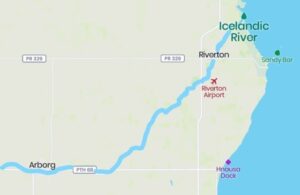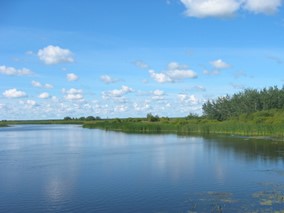
 In the summer of 1875, a delegation from Ontario came to Manitoba to explore an area on the west bank of Lake Winnipeg for an Icelandic settlement. They sailed down (north) on the Red River, out to the lake and north along the waterfront to Mikley and up along Icelandic River (Íslendingafljót). The committee members thought the land was good on both sides of the river and stated this in their report: “Lands for haymaking are best by the Icelandic River”. The map shows where the river flows through Riverton and into the lake. In the last decades of the 19th century, settlements formed: next to the lake is Fljóts, then Geysir and then Árdals-Framnes. North of Fljóts was Ísafold. To the west of Geysir were the farms Hof, Hvanneyri and Melstaður, but when Árdals-Framnes were formed, these farms were counted as part of the new settlement. Pétur Stefán Guðmundsson came from N. Dakota, took land in the new settlement and named his farm Árdal and there the settlement’s first post office, Ardal Post Office, was opened in 1902.
In the summer of 1875, a delegation from Ontario came to Manitoba to explore an area on the west bank of Lake Winnipeg for an Icelandic settlement. They sailed down (north) on the Red River, out to the lake and north along the waterfront to Mikley and up along Icelandic River (Íslendingafljót). The committee members thought the land was good on both sides of the river and stated this in their report: “Lands for haymaking are best by the Icelandic River”. The map shows where the river flows through Riverton and into the lake. In the last decades of the 19th century, settlements formed: next to the lake is Fljóts, then Geysir and then Árdals-Framnes. North of Fljóts was Ísafold. To the west of Geysir were the farms Hof, Hvanneyri and Melstaður, but when Árdals-Framnes were formed, these farms were counted as part of the new settlement. Pétur Stefán Guðmundsson came from N. Dakota, took land in the new settlement and named his farm Árdal and there the settlement’s first post office, Ardal Post Office, was opened in 1902.
The village is founded.
Settlers flocked to the new settlement from all over. Many came from the Icelandic settlements in N. Dakota, others from Winnipeg, and the settlements of Hnausa and Ísafold. In a letter published in Heimskringla in early 1904, Jón J. Hornfjörð, who came to the settlement from the Ísafold Settlement, says that the number of settlers is between 60 – 70. When cabins had been built and small areas around them cleared, residents began to consider transport. It was urgent for the inhabitants of the settlement to access the markets for necessities. Those who lived in the west had to go 32 km (20 miles) to the store in Hnausa and 40 km (25 miles) to the store in Riverton. Attempts were made to build a trail to Hnausa, but it was difficult to traverse in the summer, especially if it was raining frequently. Tryggvi Ingjaldsson came from N. Dakota and settled in the area in the spring of 1901. He solved the problem by opening a store in his home. He transported goods from Stefán Sigurðsson’s store in Hnausa. Although a few settlers had newly arrived from Iceland, most of the inhabitants were from other Icelandic settlements and they began the task to establish the settlement. A congregation was formed in 1902, a meeting house was built a year later and stood west of the village. It was both a church, a primary and secondary school, and a concert hall. The first school district was formed in the Árdal Settlement, shortly afterwards the second in Framnes. In the beginning, Icelandic settlers were the only ones in the settlement, but from 1905 onwards, Polish and Ukrainian settlers arrived and their number gradually increased. All were farmers who needed to take their produce to market. Everyone was aware of the need to strengthen transportation from the community so that products could be marketed in Winnipeg. The provincial government naturally monitored the growth of the area and approved the settlement between the large lakes in Manitoba. In 1906 a railway had come to Gimli; the railway company CPR next began preparations for the construction of a railway from Winnipeg to Árdal. As elsewhere on the plains of western Canada, a train station was needed and a location was chosen in the village. When the construction of the track was completed, the village was given a new name, Arborg.
